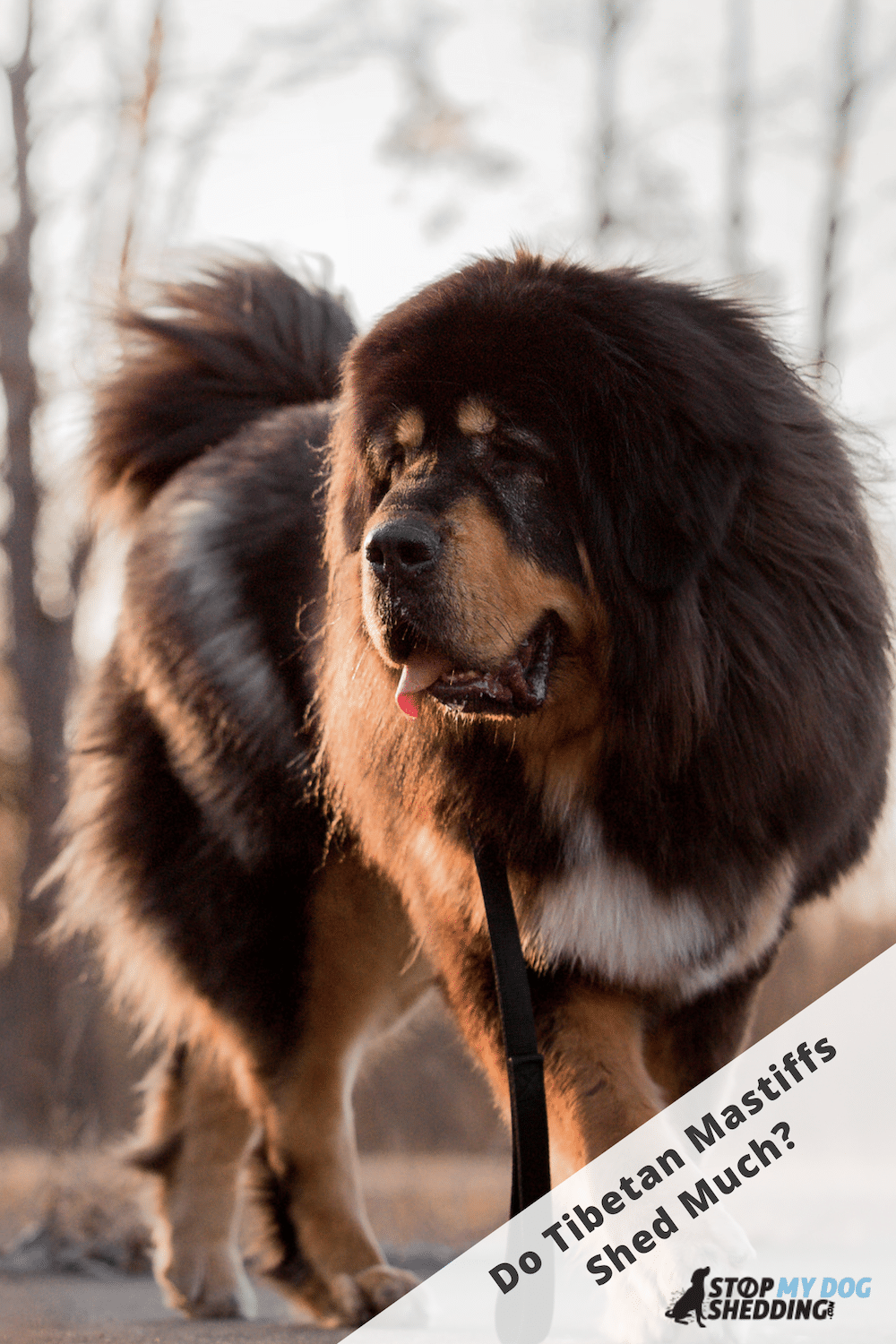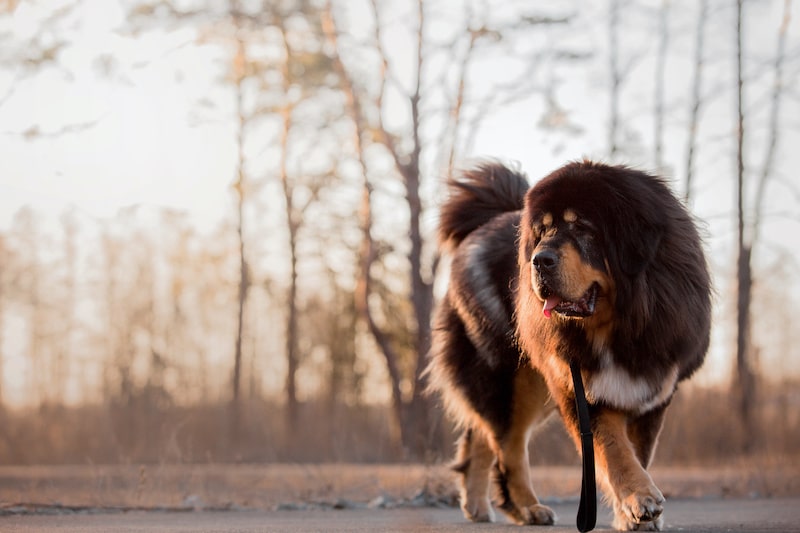Tibetan Mastiffs are large working dogs that were bred to guard sheep and local tribespeople from wolves, bears and even tigers. They are mighty, watchful and loyal guardians.
Do the shed much? Tibetan Mastiffs shed a small amount of fur throughout most of the year. However, you may notice a significantly heavier period of shedding in spring as they shed their thick winter coat. During this time, daily brushing with a slicker brush and undercoat rake can help reduce the shedding.
In this article, we’ll be taking a closer look at how much TMs shed, what they’re like to groom and how you can get the molting under control.
Tibetan Mastiff Shedding Guide
Tibetan Mastiffs are a double coated breed. They have long, thick, coarse outer guard hair and a dense, woolly undercoat.
Despite their massive coat, they don’t actually shed much throughout most of the year. They leave the bulk of their shedding for one or two “seasonal sheds” each year.
The main shedding event normally occurs in spring as they shed their winter coat. And during this 2-4 week period, you will typically notice a lot of molting. When you experience this for the first time you may wonder where on earth all that fur is coming from, but it’s actually normal for most dogs to shed seasonally like this.
It’s just that in dogs like the Tibetan Mastiff, it’s quite extreme given they have such thick double coats. Like other heavy seasonal shedders, such as the St. Bernard and Leonberger for example, they are simply shedding the coat they no longer need to make way for a more suitable coat for that particular season.
In dogdom, this is commonly referred to as “blowing coat.” And it normally happens once per year with TMs, but it’s common for dogs to shed heavier during fall too, as they molt their summer coat to make way for a thicker winter coat.
The good news is that it’s not very difficult to get this under control, it mostly comes down to brushing. So let’s take a closer look at what it takes to brush and groom them.
Recommended: Go here to see our top-rated dog hair blow dryers
What Are TMs Like to Groom?
TMs aren’t very high maintenance, you really only need to brush them once or twice per week to maintain their coat. However, if you don’t want to be spending hours behind a vacuum during shedding season, you may want to step this up to daily brushing.
During periods of “normal” shedding throughout most of the year, a slicker brush or pin brush is all you need to maintain their coat and remove the dead fur.
A slicker brush is a brush made of fine wire bristles with rubber or plastic tips on the end to protect your dog’s skin, and a pin brush is similar, but with thicker, more widely spaced pins. And together, these can help you remove any mats and tangles your TM may have developed, along with most of the old fur.
Related: The Four Main Types of Dog Grooming Brushes Compared
When your TM is blowing coat though, an undercoat rake or deshedding tool can be very effective at removing the dead fur, not just from his top coat, but also from his undercoat.
And this is especially important during periods of heavy molting as their undercoat is quite thick and woolly, so you need a brush that will reach right down to their skin to gently remove the dead undercoat fur.
Another thing to keep in mind is that they have a lion-like mane around their neck, similar to dogs like the Chow Chow for example. This is why they are commonly referred to as the “lion dog.” In any case, because of this mane, you may need to spend a little extra time here, to comb out the mats and make sure there’s no debris caught up in it.
Other than this, general maintenance items include bathing once per month or every other month, keeping his nails trimmed, and cleaning his teeth.
Recommended: Go here to see our top-rated dog hair blow dryers
Reducing the Amount of Fur Your Tibetan Mastiff Sheds
There is no way to magically stop the shedding. Dogs losing their fur is a normal process whereby the old hair stops growing, falls out, and the new batch of hair takes its place.
It is possible for dogs to shed excessively for reasons outside of what is considered normal, like if they have fleas or allergies, or if their diet isn’t as good as it could be. So if you’re concerned the shedding is beyond what is normal, contact your local vet.
However, with respect to normal shedding, your best defence is brushing, the occasional bath and making sure his diet is optimal.
Brushing is by far the simplest and most effective method as it removes the dead fur from the source. So the more you can brush off of his coat, before it fills your home, the better. It also helps prevent a dry coat (which can cause excessive shedding) because brushing spreads his natural skin oils.
Bathing isn’t something you need to do very often, but this can help during shedding season. Not only does it remove a bunch of dead fur while you’re bathing, but it loosens the old fur up and makes a subsequent brushing session that much more effective.
It’s important to keep a few things in mind though:
- Only use good quality dog shampoo, and never human shampoo, otherwise you risk drying out his skin and hair, which can actually increase shedding.
- Avoid over bathing as this can also dry out his coat, a bath once per month should suffice or maybe more during shedding season if you’re using a dog shampoo that doesn’t dry out his coat.
- Only brush once his coat is dry, or at least mostly dry, to avoid pulling at his fur and unnecessarily removing strong, healthy fur.
One tool many groomers use when bathing and brushing dogs like the Tibetan Mastiff is an air blower. These can help you get an enormous chunk of dead fur off of his coat after bathing and while you brush. You don’t need a fancy one either, just something that blows cool air.
Bottom Line
All in all, Tibetan Mastiffs are great family dogs. They are natural born guardians too, so it’s in their nature to loyally protect you, your home and loved ones.
Just keep in mind that they are highly intelligent and can be a little stubborn, not to mention territorial around strangers. Which is why socializing them and ideally having them professionally trained at a young age may be well worthwhile. Training can also help you better you understand your dog, which may make it easier for you to gain his respect as the leader.
Either way, if you’re looking for a low to moderate shedding dog that is fairly low maintenance, and don’t mind one or two periods of “coat blow” each year, you’ll love the Tibetan Mastiff. And as an added bonus, their coat lacks the dog odor most large dogs have.
With that being said, they’re not considered to be hypoallergenic, which means they may not be the best choice for allergy sufferers. No dog is truly hypoallergenic though, but some dogs, like the Tibetan Terrier, can be more suitable for allergy sufferers in this respect.













Please note: By submitting a comment using the above comment form, you confirm that you agree with the storage and handling of your data by this site as detailed in our Privacy Policy.